
The Eastern Highlands, also known as the Manica Highlands, is a mountain range on the border of Zimbabwe and Mozambique. The Eastern Highlands extend north and south for about 300 kilometres (190 mi) through Zimbabwe's Manicaland Province and Mozambique's Manica Province.

Brachystegia spiciformis, commonly known as zebrawood, or msasa, is a medium-sized African tree having compound leaves and racemes of small fragrant green flowers. The tree is broad and has a distinctive amber and wine red colour when the young leaves sprout during spring (August–September). It grows in savanna, both open woodland and closed woodland of Southern and Eastern Africa, mostly Tanzania, Zambia, Zimbabwe, Malawi and Mozambique. The word msasa is commonly used as a proper name in African place names. The word also means 'rough plant' in Swahili. Other common names: mundu, myombo, mtondo (Tanzania), muputu (Zambia). The plant is known in the Venda language as mutsiwa, which means 'the one that is left behind'. An outlying population of Brachystegia has recently been discovered in the Soutpansberg mountains of northern South Africa. This tree is a protected species in South Africa.

Miombo woodland is a tropical and subtropical grasslands, savannas, and shrublands biome located in central and southern tropical Africa. It includes three woodland savanna ecoregions characterized by the dominant presence of Brachystegia and Julbernardia species of trees, and has a range of climates ranging from humid to semi-arid, and tropical to subtropical or even temperate. The trees characteristically shed their leaves for a short period in the dry season to reduce water loss and produce a flush of new leaves just before the onset of the wet season with rich gold and red colours masking the underlying chlorophyll, reminiscent of autumn colours in the temperate zone.

Brachystegia is a genus of tree of the subfamily Detarioideae that is native to tropical Africa.

Axiocerses tjoane, the eastern scarlet, common scarlet or scarlet butterfly, is a butterfly of the family Lycaenidae. It is found in East and southern Africa.

Andronymus neander, the common dart or nomad dart, is a butterfly of the family Hesperiidae. It is found in tropical Africa. The habitat consists of moist woodland, forest margins and riparian vegetation, from sea level up to altitudes of 2,400 metres.
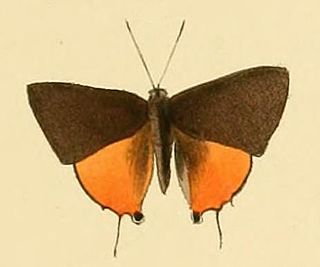
Deudorix dariaves, the black-and-orange playboy, is a butterfly of the family Lycaenidae. It is found from South Africa to Mozambique and to the coast of Kenya. In South Africa it is found along the coast of KwaZulu-Natal and north along the escarpment foothill forests to Mpumalanga and Limpopo.

Colotis subfasciatus, the lemon tip or lemon traveller, is a butterfly of the family Pieridae. It is found in the Afrotropical realm. The habitat consists of savannah and Brachystegia woodland.
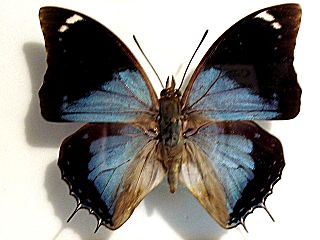
Charaxes bohemani, the large blue emperor, large blue charaxes or divebomber charaxes, is a butterfly of the family Nymphalidae. It is found in eastern and southern Africa.
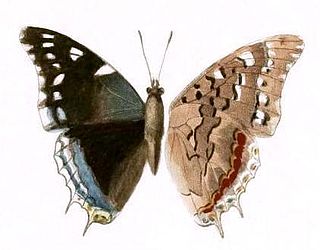
Charaxes guderiana, the blue-spangled emperor, Guderian's charaxes or blue-spangled charaxes, is a butterfly of the family Nymphalidae. It is found in southern Africa.
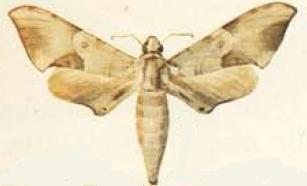
Neopolyptychus compar is a moth of the family Sphingidae. It is known from Brachystegia woodland from Zimbabwe to Mozambique, Zambia, Malawi and south-eastern Tanzania.

Bicyclus angulosa, the startled bush brown, is a butterfly in the family Nymphalidae. It is found from Senegal to Cameroon, in the Central African Republic, the Democratic Republic of the Congo, Sudan, Uganda, Ethiopia, Kenya, Angola, Tanzania, Zambia, Malawi, Mozambique and Zimbabwe. The habitat consists of dense savanna, including Brachystegia woodland.
Charaxes pseudophaeus, the false dusky charaxes, is a butterfly in the family Nymphalidae. It is found in Mozambique and eastern Zimbabwe. The habitat consists of evergreen forests and the fringes of Brachystegia woodland.
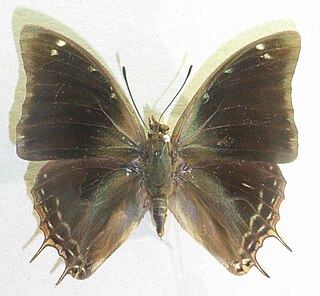
Charaxes manica, the Manica charaxes, is a butterfly in the family Nymphalidae. It is found in Zimbabwe, western Mozambique and Zambia. The habitat consists of Brachystegia woodland.

Junonia artaxia, the African pansy or commodore, is a butterfly in the family Nymphalidae. It is found in eastern Angola, the Democratic Republic of the Congo Burundi, Kenya, southern and western Tanzania, Zambia, Malawi, Mozambique and Zimbabwe. The habitat consists of Brachystegia woodland.
Neptis penningtoni, or Pennington's sailer, is a butterfly in the family Nymphalidae. It is found in south-eastern Kenya, western Tanzania, Zambia, Mozambique, Zimbabwe and South Africa (Limpopo). The habitat consists of Brachystegia woodland, especially on wooded hills.
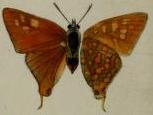
Aphnaeus erikssoni, the Eriksson's highflier, is a butterfly in the family Lycaenidae. It is found in Angola, Namibia, Zambia, the Democratic Republic of the Congo, Tanzania, Malawi, Mozambique and Zimbabwe. The habitat consists of savanna and open woodland.

Acada annulifer, the dark axehead skipper, is a butterfly in the family Hesperiidae. It is found in Nigeria, Cameroon, Gabon and the Democratic Republic of the Congo. The habitat consists of forests.

Calleagris jamesoni, Jameson's flat or Jameson's skipper, is a butterfly in the family Hesperiidae. It is found in Angola, the Democratic Republic of the Congo, Tanzania, Zambia, Malawi, Mozambique, Zimbabwe and Botswana. Their habitat consists of Brachystegia woodland, savanna and forest margins.
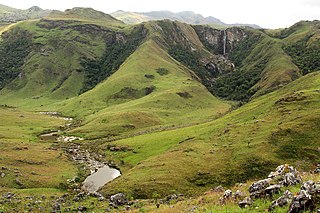
The Chimanimani Mountains are a mountain range on the border of Zimbabwe and Mozambique. The mountains are in the southern portion of the Eastern Highlands, or Manica Highlands, a belt of highlands that extend north and south along the international border, between the Zambezi and Save rivers.














